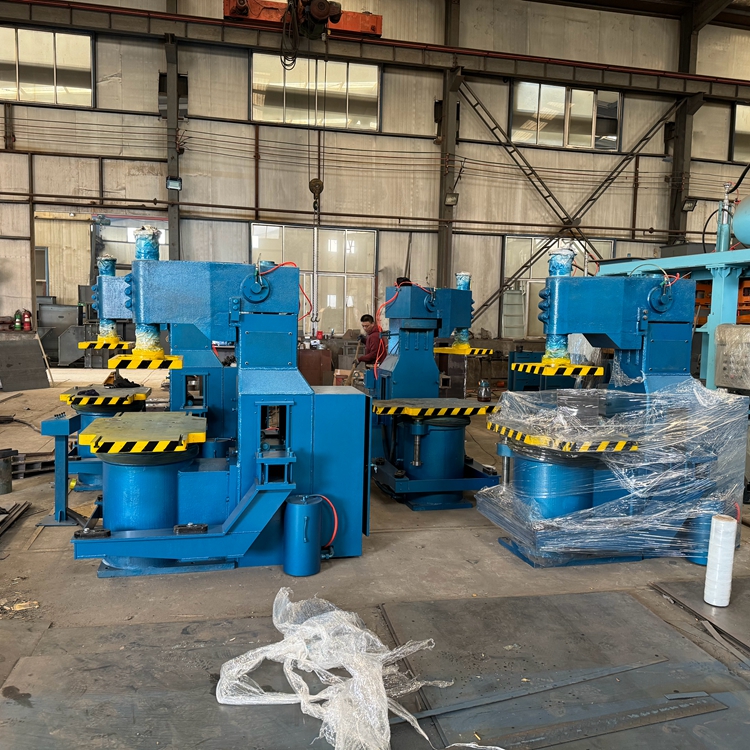Wet sand vibration extrusion molding machine
Model Z148WK
Products
Products DETAILS
Wet sand vibration extrusion molding machine
| NameModel | Z143W | Z145WB | Z146WK | Z147WK | Z148WB | Z148WK | Z149WK |
| Sand box inner dimensions(mm) | 500*400 | 550*450 | 600*500 | 800*600 | 800*600 | 1000*630 | 1050*930 |
| Work surface size(mm) | 560*420 | 600*550 | 700*550 | 800*575 | 900*730 | 1200*730 | 1200*1030 |
| Shock load(kgf) | 200 | 300 | 400 | 400 | 600 | 1200 | 1200 |
| Compacting strength(kgf) | 4200 | 6300 | 7500 | 8000 | 10000 | 16000 | 16000 |
| Ejection stroke(mm) | 160 | 180 | 200 | 220 | 250 | 250 | 350 |
| productivity(Box/h) | 40-60 | 40-60 | 40-60 | 40-60 | 40-60 | 40-60 | 40-60 |

Technical features:
1. The structure of the machine is optimized and designed. The fuselage adopts a square box frame structure, which greatly improves the rigidity of the fuselage.
2. This machine adopts the vibration molding process, which can greatly increase the compaction force, make the sand mold hardness reach more than HB90, increase the surface roughness by one level, and stabilize the product quality.
3. The shock part of this machine is a spring micro-shock type, which effectively reduces the impact on the foundation.
4. The mold ejection mechanism of this machine adopts single cylinder mold ejection, which has good synchronization.
5. The control part of this machine all uses pneumatic components to realize the overall function, which is simple to operate and easy to maintain.
6. The machine is easy to operate, the sand mold condition can be visualized, and the operating procedures can be humanized, effectively improving productivity.



Use air or hydraulic pressure to apply pressure to the molding sand in the flask through a pressure head or pattern to compact the molding sand. The pressure is generally 0.25~0.4 MPa. This kind of molding machine makes the sand mold far away from the pressure surface poor in compactness. In the early 1950s, high-pressure molding machines appeared, and the pressure on the sand mold plane was above 0.7 MPa. The pressure heads of high-pressure molding machines are divided into several structural forms, such as flat pressure heads, forming pressure heads and multi-contact pressure heads. Among them, high-voltage multi-contact molding machines are the most widely used. The pressure head of the high-pressure multi-contact molding machine is divided into many small squares-contacts that can move up and down. A large pressing force can be obtained through the hydraulic cylinder. During compaction, each contact exerts corresponding pressure according to the height of the mold below it (that is, the thickness of the compressed sand layer), so that the sand mold obtains high and uniform compactness and hardness. This type of molding machine is equipped with a micro-shock shock mechanism, which can adapt to complex shapes. High-voltage multi-contact molding machines mostly adopt a four-column structure, with single-station and double-station types. In order to adapt to the production of small and medium-sized batches of castings, this type of molding machine is often equipped with a template quick-changing device. When changing the template, the molding machine does not need to be shut down. Using high-pressure multi-contact molding, sand casting can cast castings with thin walls, precise dimensions and smooth surfaces.
Shock molding machine
This type of molding machine can be divided into two types: shock-type and micro-shock molding machines. The sand box and pattern are fixed on the workbench of the molding machine. When the workbench falls, the collision with the impact surface of the anvil and the inertia of the sand grains are used to tighten the sand mold. This type of molding machine has serious noise and the compactness of the upper part of the sand mold is very low. It has been replaced by micro-seismic compaction molding machines.
Shock molding machine
By compacting the shaken sand mold, a sand mold with tight upper and lower parts can be obtained. Commonly used is the micro-seismic compaction molding machine (see picture), which uses the drop of the workbench to collide with the floating vibrating iron, micro-vibration to compact the molding sand, and then compact it. Microshocks replace the low frequency (60~120 times/min) and large amplitude vibrations of the shock molding machine with vibrations of higher frequency (500~1000 times/min) and small amplitude (5~25 mm). The sand molds produced by this molding machine are of good quality and have low basic requirements. Molding machine











